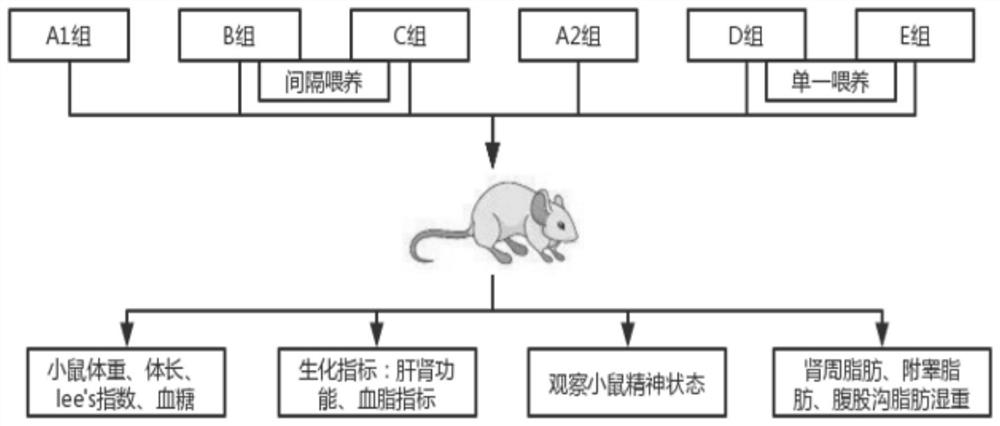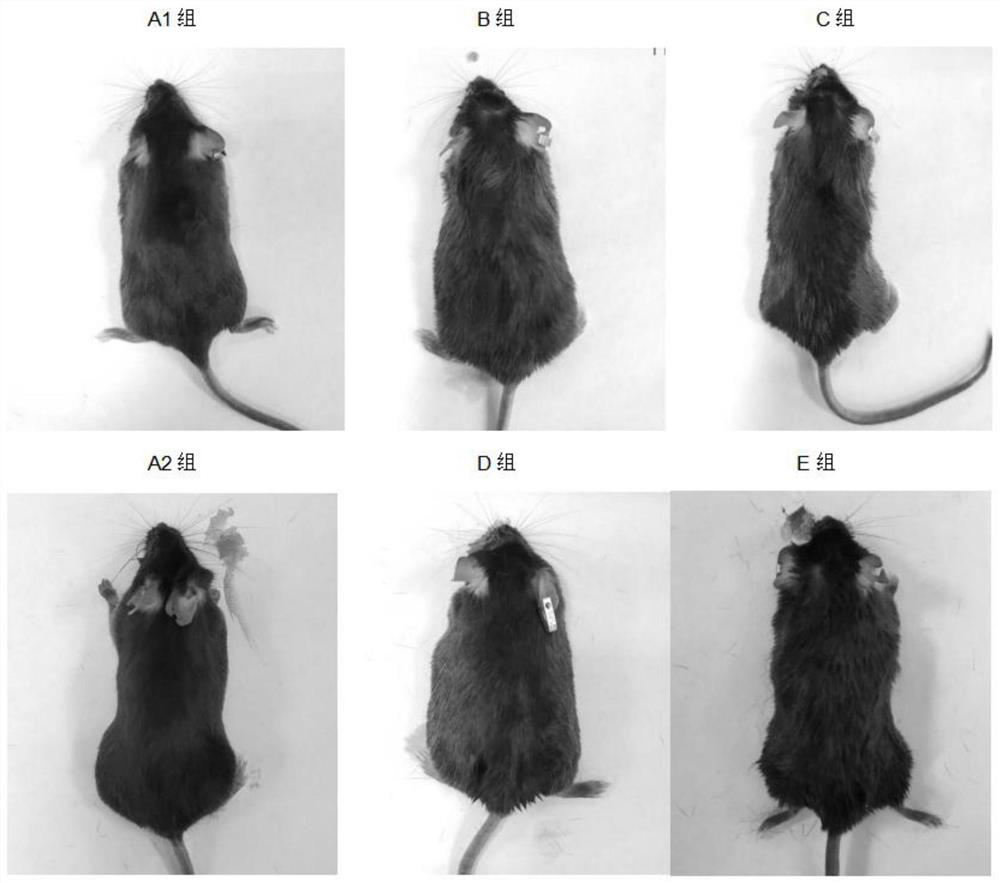High-fat feed for efficiently constructing mouse obesity model and modeling method
A high-fat feed and obesity model technology, applied in the biological field, can solve the problems of low food utilization rate, seborrheic depilation, low palatability, etc., to achieve increased obesity rate and palatability, less hair oil lumps, and improved palatability effect
- Summary
- Abstract
- Description
- Claims
- Application Information
AI Technical Summary
Problems solved by technology
Method used
Image
Examples
Embodiment 1
[0035] Embodiment 1: the making of high-fat feed
[0036] A high-fat feed for efficiently constructing a mouse obesity model provided in Example 1 is a 60% fat-powered high-fat feed (abbreviated as the feed of the present invention), which is entrusted to Jiangsu Synergy Pharmaceutical Bioengineering Co., Ltd. to complete the production. The high-fat feed The feed is composed of the following components by weight percentage: 23% casein, 0.39% L-cystine, 6.46% cellulose, 6.46% mixed minerals, 0.13% mixed vitamins, 0.26% choline bitartrate, 11% glucose, 14.15% maltodextrin, 2.53% peanut oil, 2.53% sesame oil, 28% margarine, 5.09% taro-flavored milk tea powder.
[0037] Mixed minerals are composed of the following components by weight percentage: 17.985% corn starch, 33% potassium citrate monohydrate, 26% calcium hydrogen phosphate, 11% calcium carbonate, 5.18% sodium chloride, 5.152% magnesium sulfate heptahydrate, 0.838 % heavy magnesium oxide, 0.42% ferric citrate, 0.245% man...
Embodiment 2
[0045] 1. A method for constructing a mouse obesity model provided, comprising the steps of:
[0046] (1) Purchase and select 30 6-week-old C57BL / 6J male mice weighing 22.46g ± 1.2g, and divide them into 6 groups according to A1, B, C, A2, D, and E, with 5 mice in each group , A1, B, and C three groups are interval feeding methods, wherein, A1 is a control group fed with common growth and breeding feed, B is a model group fed with feed of the present invention, C is a model group fed with XTHF60, A2, D , E is a single feeding method, wherein, A2 is a control group that feeds common growth and breeding feed, D is a model group that feeds feed of the present invention, and E is a model group that feeds XTHF60;
[0047] (2) Each group of mice in step (1) is free to eat and drink every day, the room temperature is kept at 20-22°C, the humidity is 55%-65%, and the light is 10-15h;
[0048] (3) The mice in group A1 were fed with common growth and breeding feeds until 100% of the mi...
Embodiment 3
[0071] Embodiment 3 experimental result
[0072] 1. Mouse body weight (Table 2)
[0073] At the end of the first week, the weight gain of group B was extremely significant (P<0.001), indicating that this formula has a high palatability and can achieve rapid weight gain in the early stage. At the end of the 6th week, compared with group A1, the average body weight of group B increased by about 24.88% (P<0.001), meeting the obesity standard of mice. Within 6 weeks, the average body weight of group B increased by 8.4g, but that of group C only increased by about 5g, which was significant (P<0.01). The mice in group D (feed of the present invention + single feeding method) needed 9 weeks for modeling, and the average weight gain of the mice was 10 g, and the average weight increased by about 33.86% compared with the average weight of group A2 (P<0.001). Using the feed formula of the present invention has advantages in two kinds of modeling methods. At first, under the premise th...
PUM
 Login to View More
Login to View More Abstract
Description
Claims
Application Information
 Login to View More
Login to View More - R&D
- Intellectual Property
- Life Sciences
- Materials
- Tech Scout
- Unparalleled Data Quality
- Higher Quality Content
- 60% Fewer Hallucinations
Browse by: Latest US Patents, China's latest patents, Technical Efficacy Thesaurus, Application Domain, Technology Topic, Popular Technical Reports.
© 2025 PatSnap. All rights reserved.Legal|Privacy policy|Modern Slavery Act Transparency Statement|Sitemap|About US| Contact US: help@patsnap.com



